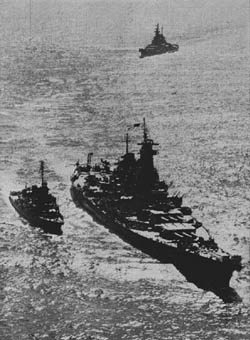Battleship USS Missouri from All Hands, Bureau of Naval Personnel Information Bulletin, October 1945.
‘THE PEOPLE OF MISSOURI CAN TAKE PRIDE…’
On 29 Jan 1944, the Senator from Missouri, Harry Truman, spoke at the launching of the nation’s mightiest battlewagon, the USS Missouri. He said: “The time is surely coming when the people of Missouri can thrill with pride as the Missouri and her sister ships sail into Tokyo Bay.”
MISSOURI, flanked by destroyer, steams into Tokyo Bay. Astern is the Iowa.
Eighteen months later, the Senator had become President and the Missouri was destined to play an even more dramatic role than had been anticipated either during her launching or during the months of bitter fighting when she helped devastate the Jap war machine. For it was the Missouri that was selected for the formal surrender signing.
The $100,000,000-dreadnaught is an apt symbol of the great role played by the Navy in the defeat of Japan. The equivalent of an 18-story building in height—with seven of these stories under water—the Missouri helped batter Iwo Jima, Okinawa, and the Tokyo area.
The Missouri, like other American capital ships, suffered from a Kamikaze hit. On 11 April a Jap suicide plane crashed into her superstructure and then hit her starboard side aft. The resulting fire was quickly extinguished and the Missouri did not even alter her course.
By the middle of July, when the Navy prepared for what was to be the final blow at Japan, Admiral Halsey chose the Missouri as flagship of the Third Fleet.
The 45,000-ton man o’ war—she is the same class as the Iowa, New Jersey and Wisconsin—is the fourth warship of her name. The first was a side-wheeled frigate completed in 1842. She was destroyed by fire while anchored in Gibraltar in 1844. The second Missouri was a Confederate iron-clad steam ram.
The third of that name, a 12,500-ton battleship, put to sea about 40 years ago and aboard was a young midshipman named Bill Halsey, today the Admiral in command of the Third Fleet. She was scrapped in 1922 under the Washington Treaty.










